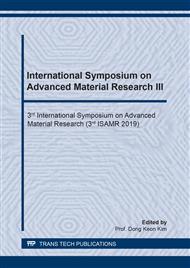[1]
J. Chiu, C. Shu. Effects of disturbed flow on vascular endothelium: pathophysiological basis and clinical perspectives. Physiological Reviews. 12 (2011) 203-207.
DOI: 10.1152/physrev.00047.2009
Google Scholar
[2]
G. Scot, W.P. Serruys. Coronary stents: looking forward. Journal of the American College of Cardiology. 5 (2010) 562-571.
Google Scholar
[3]
K.S. Cunningham, A.I. Gotlieb. The role of shear stress in the pathogenesis of atherosclerosis. Laboratory Investigation. 23 (2005) 56-59.
Google Scholar
[4]
A.J. Carter, D. Scott, D. Rahdert, et al. Stent design favorably influences the vascular response in normal porcine coronary arteries. The Journal of invasive cardiology. 9 (2000) 123-126.
Google Scholar
[5]
T. Palmerini, B.Z. Giuseppe, R.D. Diego, C. Stettler, et al. Stent thrombosis with drug-eluting and bare-metal stents: evidence from a comprehensive network meta-analysis. The Lancet. 24 (2012) 201-205.
DOI: 10.1016/s0140-6736(12)60324-9
Google Scholar
[6]
B. Cortese, A. Bertoletti, S. De Matteis, G.B. Danzi, A. Kastrati. Drug-eluting stents perform better than bare metal stents in small coronary vessels: A meta-analysis of randomised and observational clinical studies with mid-term follow up. International Journal of Cardiology. 2 (2011) 128-132.
DOI: 10.1016/j.ijcard.2011.04.016
Google Scholar
[7]
H. Samady, P. Eshtehardi, C.M. McDaniel, et al. Coronary Artery Wall Shear Stress Is Associated With Progression and Transformation of Atherosclerotic Plaque and Arterial Remodeling in Patients With Coronary Artery Disease. Circulation. 7 (2011) 59-71.
DOI: 10.1161/circulationaha.111.021824
Google Scholar
[8]
S.Y. Chatzizisis, A.U. Coskun, M. Jonas, et al. Role of Endothelial Shear Stress in the Natural History of Coronary Atherosclerosis and Vascular Remodeling. Journal of the American College of Cardiology. 25 (2007) 103-106.
DOI: 10.1016/j.jacc.2007.02.059
Google Scholar
[9]
C.M. Agrawal, K.F. Haas, D.A. Leopold, H.G. Clark. Evaluation of poly[-Llactic acid] as a material for intravascular polymeric stents. Biomaterials. 6 (1992) 98-102.
DOI: 10.1016/0142-9612(92)90068-y
Google Scholar
[10]
P. H. Stone, S. Saito, S. Takahashi, et al. Prediction of Progression of Coronary Artery Disease and Clinical Outcomes Using Vascular Profiling of Endothelial Shear Stress and Arterial Plaque Characteristics: The Prediction Study. Circulation. 2 (2012) 36-39.
DOI: 10.1161/circulationaha.112.139501
Google Scholar
[11]
M.H. Friedman, C.B. Bargeron, O.J. Deters, G.M. Hutchins, F.F. Mark. Correlation between wall shear and intimal thickness at a coronary artery branch. Atherosclerosis. 5 (1987) 88-95.
DOI: 10.1016/0021-9150(87)90090-6
Google Scholar
[12]
N. Patel, A.P. Banning. Bioabsorbable scaffolds for the treatment of obstructive coronary artery disease: the next revolution in coronary intervention?. Heart. 17 (2013) 368-372.
DOI: 10.1136/heartjnl-2012-303346
Google Scholar
[13]
S. Nishio, K. Kosuga, K. Igaki, et al. Long-Term (>10 Years) Clinical Outcomes of First-in-Human Biodegradable Poly-l-Lactic Acid Coronary Stents: Igaki-Tamai Stents. Circulation. 19 (2012) 198-203.
DOI: 10.1161/circulationaha.110.000901
Google Scholar
[14]
E.R. Edelman, C. Rogers. Pathobiologic responses to stenting. The American Journal of Cardiology. 5 (1998) 201-206.
Google Scholar
[15]
S. Morlacchi, B. Keller, P. Arcangeli, et al. Hemodynamics and in-stent restenosis: micro-CT images, histology, and computer simulations. Annals of Biomedical Engineering. 11 (2011) 138-141.
DOI: 10.1007/s10439-011-0355-9
Google Scholar
[16]
T. Okamura, S. Garg, J.L. Gutierrez-Chico. In vivo evaluation of stent strut distribution patterns in the bioabsorbable everolimus-eluting device: an OCT ad hoc analysis of the revision 1.0 and revision 1.1 stent design in the ABSORB clinical trial. Eurointervention. 19 (2010) 198-203.
DOI: 10.4244/eijv5i8a157
Google Scholar
[17]
Daixiu Wei, Yuichiro Koizumi, Akihiko Chiba. Porous surface structures in biomedical Co-Cr-Mo alloy prepared by local dealloying in a metallic melt. Materials Letters. 91 (2018) 998-1003.
DOI: 10.1016/j.matlet.2018.02.072
Google Scholar
[18]
Zhang Z, Jing Y, Liu X. Microalloyed Zn-Mn alloys: From extremely brittle to extraordinarily ductile at room temperature. Materials & Design. 20 (2018) 123-131.
DOI: 10.1016/j.matdes.2018.02.049
Google Scholar
[19]
Qi Zhang, Kewen Li, Jinhong Yan, Zhuo Wang, Qi Wu, Long Bi, Min Yang, Yisheng Han. Graphene coating on the surface of CoCrMo alloy enhances the adhesion and proliferation of bone marrow mesenchymal stem cells. Biochemical and Biophysical Research Communicatio. 13 (2014) 223-227.
DOI: 10.1016/j.bbrc.2018.02.152
Google Scholar
[20]
L Li, L Cui, R Zeng, S Li, X Chen, Y Zheng, M. Bobby Kannan. Advances in functionalized polymer coatings on biodegradable magnesium alloys - A review. Acta Biomaterialia. 81 (2017) 981-987.
DOI: 10.1016/j.actbio.2018.08.030
Google Scholar
[21]
Pedram Sotoudehbagha, Saeed Sheibani, Mehrdad Khakbiz, Somayeh Ebrahimi-Barough, Hendra Hermawan. Novel antibacterial biodegradable Fe-Mn-Ag alloys produced by mechanical alloying. Materials Science & Engineering C. 26 (2006) 364-369.
DOI: 10.1016/j.msec.2018.03.005
Google Scholar
[22]
Paulina A. Trzaskowska, Beata Butruk-Raszeja, Ewa Rybak, Tomasz Ciach. Electropolymerized hydrophilic coating on stainless steel for biomedical applications. Colloids and Surfaces B: Biointerfaces. 22 (2015) 336-338.
DOI: 10.1016/j.colsurfb.2018.04.052
Google Scholar


